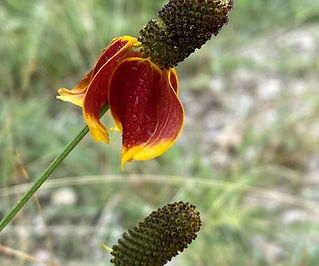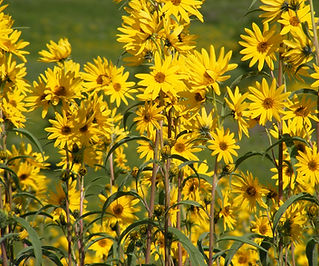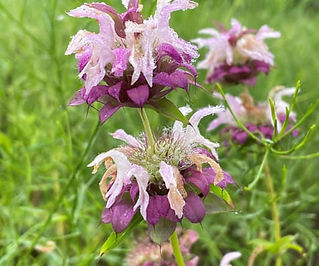Wildflowers
For latest pricing and availability call: (325) 514-1779 or Email: broncoseedgrain@gmail.com

Texas Bluebonnets
Texas Bluebonnets are the Official State Flower of Texas, one of the most iconic native plants in Texas, and are the most well-known native wildflower in Texas. Bluebonnets are native, annual legumes that grow 1-2’ in height with showy blue flowers with white centers. Texas bluebonnets are widely distributed across Texas and grow well in all soils except very loose sands, which are better suited to grow Sandyland Bluebonnets. In addition to their showy blooms and iconic displays, Texas bluebonnets are excellent pollinator plants, particularly for honeybees. Texas Bluebonnets also produce seed eaten by quail and other birds, and white-tailed deer, cattle, and sheep and goats will graze the foliage and flowers. Texas Bluebonnets are a mainstay of wildflower seed mixes, pollinator habitat plantings, in landscape applications,and for use as a winter annual cover in conjunction with range and wildlife habitat restoration efforts.
The best time to plant bluebonnets is in the fall, between August and November. They will germinate, form a winter rosette until spring, and begin blooming in late February through May depending on the location and severity of the winter. Once established, Texas Bluebonnets will usually reseed themselves for years to come if allowed to mature fully, and they will then grow in subsequent years, especially if grasses and other vegetation are mowed annually. We offer only the highest quality Texas Bluebonnet seed that we either grow ourselves or source from reputable growers. Our bluebonnet seed is backed by current seed quality analyses. In addition, a portion of our Texas Bluebonnet seed is scarified to insure germination in the planting year under favorable rainfall conditions; some dormant seed is also present, to guard against total planting failure in the event of drought or poor emergence conditions.
Planting depth: 1/4 inch deep. This gives the seed the benefits of having the shortest distance to travel to the surface while also being deep enough to keep moisture. While Texas Bluebonnets are often simply broadcast on the soil surface, best results will come from plantings where existing vegetation is mowed, the soil surface is disturbed, the seed is incorporated into bare soil, and some effort to then cover the seed with additional soil is made. If simply overseeding existing vegetation without some seedbed preparation, consider planting larger quantities of seed to achieve an acceptable stand.
Planting Rate/acre: 1-2 lbs
Price Per Bag
Bag Sizes Available: 40# - 25# - 10# - 5# - 2# - 1# - .25# - 1oz - 1 packet

Fuego Indian Blanket
Fuego Indian Blanket was developed by the USDA NRCS Plant Materials Center in Kingsville and the Texas Native Seeds Program at the Caesar Kleberg Wildlife Research Institute. It is comprised of three native populations collected from Cameron, Galveston, and Nueces Counties of Texas. Fuego Indian Blanket has had excellent performance on a variety of soil types including saline soils and alkaline. It is highly competitive with common weeds and invasive grasses. Fuego is recommended for use in roadside beautification, pollinator plantings, native landscaping, xeriscapes, wildlife plantings,right of way revegetation, energy reclamation, and as a component of range and wildlife habitat restoration seed mixes.
Indian Blanket is a common native forb or wildflower found throughout Texas and the southwest. Other names for the plant include Blanket Flower, Firewheel, and Gaillardia, It is a prolific bloomer, and will produce showy red and yellow flowers from early spring through late fall under favorable moisture conditions. Indian blanket attracts as many as 50 different butterflies and moths, including as a food source for caterpillars of the highly specialized Gaillardia Flower Moth and the Painted Schinia Butterfly, whose wing colors and patterns mimic Indian Blanket petals. Indian blanket is also a frequent nectar plant for the monarch butterfly and a source of pollen for native bees, bumblebees,and honeybees.
In 2005, Mark Simmons, Ph.D., of the Lady Bird Johnson Wildflower Center discovered that populations of the invasive species bastard cabbage could be dramatically reduced by overseeding Indian Blanket. Indian Blanket is also highly competitive with many non-native grasses, including Buffelgrass, Old World bluestems, and Lehmann lovegrass. It is an excellent choice for projects aimed at increasing native plant diversity in stands of these grasses.
Planting Rate/acre: 3-5 lbs
Price Per Bag
Bag Sizes Available: 50# - 25# - 10# - 5# - 2# - 1# - 1 packet

Scarlet Sage
Scarlet sage is a native, warm season perennial wildflower that grows 1-3’ tall. It produces numerous red blooms and is an excellent pollinator and hummingbird attractant. In fall the blooms attract monarchs. Scarlet sage is extremely shade tolerant and is a good choice for areas beneath large trees. Scarlet sage is also a great wildflower for sandy soils.
Planting Rate/acre: 5-8 lbs
Price Per Bag
Bag Sizes Available: 50# - 25# - 10# - 5# - 2# - 1# - 1 packet

Purple Coneflower
Purple coneflower is a native, warm season perennial wildflower that grows 1-3’ tall. It has large purple to pink blooms and is an excellent pollinator attractant.
Planting Rate/acre: 3-5 lbs
Price Per Bag
Bag Sizes Available: 50# - 25# - 10# - 5# - 2# - 1# - 1 packet

Mexican Hat
Mexican hat is a native, warm season annual wildflower that grows 1-3’ tall. It produces numerous yellow, orange, and red blooms and is an excellent pollinator attractant. Mexican hat is usually avoided by deer and livestock.
Planting Rate/acre: 2-4 lbs
Price Per Bag
Bag Available Sizes: 50# - 25# - 10# - 5# - 2# - 1# - 1 packet

Plains Coreopsis
Plains coreopsis is a native, warm season annual wildflower that grows 1-3’ in height at maturity. It grows on most soil types and in all regions of Texas. It produces copious blooms of yellow flowers with black centers. Plains coreopsis is a hardy wildflower and will bloom throughout the year with moisture. It will tolerate wet soils and sites that are occasionally inundated.
Planting Rate/acre: 1-2 lbs
Price Per Bag
Bag Sizes Available: 50# - 25# - 10# - 5# - 2# - 1#

Purple Prarie Clover
Bright purple blossoms mid-summer through fall. Stunning when planted with Butterflyweed, Black-Eyed Susan, and any of the shorter prairie grasses. An important prairie legume that fixes nitrogen in the soil. Grows 1-3' tall on most well-drained soils ranging from dry sand to clay. Perennial. Hardy to zone 4.
Planting Rate/acre: 3-5 lbs
Price Per Bag
Bag Sizes Available: 50# - 25# - 10# - 5# - 2# - 1# - 1 packet
.jpg)
Engleman Daisy
Engelmann Daisy is a native, cool-season perennial forb which can grow up to 3’ tall with showy yellow flowers. Engelmann Daisy is adapted to a wide range of soil types and climate conditions, but is found most frequently throughout south, central, and west Texas, often on roadsides or in areas protected from continuous heavy grazing. Engelmann daisy is good livestock forage, and is frequently browsed by white-tailed deer. It is also an important pollinator plant due to its long flowering period and spring through early summer bloom time. The plant is commonly used in wildlife habitat and range restoration seed mixes, in wildlife plantings, for pollinators, and in wildflower seed mixes. Engelmann Daisy has a deep tap root which makes it a hardy, drought tolerate species.
Eldorado Engelmann Daisy was developed and released by the USDA NRCS Knox City Plant Materials Center. This variety originates from a composite collection of seed from native plants growing northwest of Eldorado, Texas in Schleicher County.
Planting Rate/acre: 5-10 lbs
Price Per Bag
Available Bag Sizes: 50# - 25# - 10# - 5# - 2# - 1# - 1 packet

Maximillion Sunflower
Maximilian Sunflower is a tall herbaceous perennial native to central North America. Scientifically known as Helianthus maximiliani, it grows 4-10′ tall in full sun and well drained soil. Blooming numerous 3-4″ daisy-like flowers in late summer, it’s nectar and pollen attracts large numbers of bees and butterflies, while it’s seeds attract birds.
Planting Rate/acre: 5-8 lbs
Price Per Bag
Bag Sizes Available: 50# - 25# - 10# - 5# - 2# - 1#

Native Sunflower
Native sunflower is, warm season annual forb growing 5-7’ tall with numerous showy yellow flowers. Native sunflowers are adapted to a wide range of soil conditions throughout the Southern U.S. They are an important food source for doves, quail, turkey, and songbirds. Sunflowers are also an excellent pollinator plant. Native sunflower is a common plant for game bird food plots, pollinator plantings, and for ornamental uses.
Due to a high percentage of dormant seed, native sunflowers typically require at least one year of overwintering in the ground to produce a solid stand, so they are often planted in the fall for emergence the following spring. Once established, the species will readily reseed itself and come back year after year with soil disturbances such as fall or winter dicing.
Planting Rate/acre: 5-10 lbs
Price Per Bag
Bag Sizes Available: 50# - 25# - 10# - 5# - 2# - 1#

Texas Maroon Bluebonnets
Texas Maroon Bluebonnets are a special variation of bluebonnets developed and increased in conjunction with Dr. Jerry M. Parsons, retired professor and Texas A&M Extension Horticulturist. The original plant was found in a planting of ‘Abbott Pink’ near La Pryor, Texas and has taken over 30 years to develop. The ‘Texas Maroon’ bluebonnet cannot tolerate poorly drained, clay based soils. Prefers a sloped area in light to gravelly, well-drained soil. Requires full sun. Cross-pollination will occur in future generations. To keep plants true to color, remove any plant that blooms in off-color shades other than red-maroon as soon as possible.
Planting Rate: 1-2 lbs
Price Per Bag
Bag Sizes Available: 40# - 25# - 10# - 5# - 2# - 1# - .25# - 1oz -
1 packet

Purple Heart Bluebonnets
‘Purple Heart’ bluebonnets are a special variation of bluebonnets developed and increased in conjunction with Dr. Jerry M. Parsons, retired professor and Texas A&M Extension Horticulturist. This bluebonnet has a deep purple center as opposed to typical bluebonnets with a white heart. The ‘Purple Heart’ bluebonnet cannot tolerate poorly drained, clay based soils. Prefers a sloped area in light to gravelly, well-drained soil in full sun.
Planting Rate/acre: 1-2 lbs
Price Per Bag
Bag Sizes Available: 40# - 25# - 10# - 5# - 2# - 1# - .25# - 1oz -
1 packet

Rio Grande Clammyweed
Rio Grande Clammyweed is a native, warm season annual forb that grows to 3’ in height with showy pink flowers. Clammyweed is well adapted to most soils in south, central, and west Texas, and can be used in butterfly and pollinator gardens throughout the south. Clammyweed is not grazed by livestock or wildlife, making it a suitable reclamation species for disturbed areas where livestock cannot be excluded. Clammyweed is a highly preferred food source for mourning doves and bobwhite quail when available, and it is also one of the most attractive pollinator plants available. In one trial near Kingsville, Texas, over 50 butterfly species were documented as utilizing the species during summer. Recommended uses of Rio Grande Clammyweed include for game bird food plots, pollinator plantings, roadside beautification, and as component of wildflower, erosion control, and range and wildlife habitat restoration seed mixes.
Rio Grande Clammyweed is a composite of collections from Dimmit and Zapata counties developed by the Texas Native Seed Program and the USDA NRCS South Texas Plant Materials Center. Clammyweed is easily established from seed, and it is one of the few native plants that will often emerge and establish without rainfall if soil moisture conditions are favorable at planting. This species is naturally endemic to Texas.
Planting Rate/acre: 3-5 lbs
Price Per Bag
Bag Sizes Available: 50# - 25# - 10# - 5# - 2# - 1# - 1 packet

Lemon Mint
Lemon mint is a native, warm season annual wildflower that grows 1-3’ tall. It produces stacked blossoms on the upright stems with pink and cream colored petals. A wide array of pollinators utilize the plant. Lemon mint will bloom throughout the spring and summer with good moisture
Planting Rate/acre: 0.5-1 lb
Price Per Bag
Bag Sizes Available: 50# - 25# - 10# - 5# - 2# - 1# - 1 packet

Black-Eyed Susan
Black-eyed Susan is a native, warm season annual or short-lived perennial wildflower that grows 1-3’ tall. It produces numerous yellow blooms with prominent black centers, and is an excellent pollinator attractant. It grows throughout Texas and is a good choice in areas where deer may limit the growth of more palatable species.
Planting Rate/acre: 1-2 lbs
Price Per Bag
Bag Sizes Available: 50# - 25# - 10# - 5# - 2# - 1# - 1 packet

Clasping Coneflower
Clasping coneflower is a native, warm season annual wildflower that grows 1-3’ tall. It produces numerous yellow blooms and is an excellent pollinator attractant. The plant is named for the way the leaves wrap around the stem at the bases. The leaves and stems are blue-green in color. Clasping coneflower is tolerant of wet areas and grows well along drainages and in moist soils
Planting Rate/acre: 1-3 lbs
Price Per Bag
Bag Sizes Available: 50# - 25# - 10# - 5# - 2# - 1# - 1 packet

Lanceleaf Coreopsis
Lanceleaf coreopsis is a native, warm season perennial wildflower that grows 1-3’ tall. It produces numerous yellow blooms with orange centers and is an excellent pollinator attractant. Lanceleaf coreopsis is easy to establish and is a persistent and showy wildflower.
Planting Rate/acre: 1-2 lbs
Price Per Bag
Bag Available Sizes: 50# - 25# - 10# - 5# - 2# - 1# - 1 packet

Greenthread
Greenthread is a native, warm season annual or short-lived perennial wildflower that grows 1-3’ tall. It produces numerous yellow blooms with brown to reddish centers. The leaves are threadlike, thus the name of the plant. Greenthread is an excellent pollinator attractant and it will bloom throughout the spring, summer, and fall with good soil moisture. Greenthread is very drought tolerant and grows well on dry, rocky soils over limestone. It is one of the most common wildflowers over much of the Texas Hill Country. Deer do not readily browse the plant, making it a good choice for areas with high deer numbers
Planting Rate/acre: 3-5 lbs
Price Per Bag
Bag Sizes Available: 50# - 25# - 10# - 5# - 2# - 1# - 1 packet

Awnless Bushsunflower
Simsia calva, commonly known as the Awnless Bush Sunflower or Bush Sunflower, is a lovely native wildflower to consider adding to your Texas garden. This sunflower species belongs to the Asteraceae family and is found in the states of New Mexico and Texas. The Awnless Bush Sunflower is a hardy perennial plant that can reach up to 2-3 feet in height and spread about 1-2 feet wide. It thrives in full sun and well-drained soil, making it an ideal addition to any garden bed, rock garden, or container garden. Once established, it is drought tolerant and requires little maintenance.
In the late summer and fall, the Awnless Bush Sunflower blooms with cheery yellow flowers that attract a variety of pollinators, including butterflies and bees. The flowers have a diameter of about 1 inch and sit atop long stems, adding a nice vertical element to any garden.
Planting Rate/acre: 2-3 lbs
Price Per Bag
Bag Available Sizes: 50# - 25# - 10# - 5# - 2# - 1# - 1 packet
.jpg)
Partridge Peas
Partridge pea is a native, annual legume that grows 1-3’ in height with showy yellow blooms throughout the growing season after rain. It best adapted to sandy soils in Texas. Partridge pea seed is relished by game birds and it is an important food source for bobwhite quail in many regions. It is also an important pollinator plant for various butterflies and honeybees. It can be potentially toxic to livestock in large quantities, but it is usually avoided by most grazers if other forages are available.
Partridge pea is an excellent native legume for inclusion in range and wildlife habitat restoration plantings, pollinator plantings, and as a component of game bird food plots. It establishes easily from seed, and once established, typically reseeds itself annually with soil disturbance.
Planting Rate/acre: 1-2 lbs
Price Per Bag
Bag Sizes Available: 50# - 25# - 10# - 5# - 2# - 1#